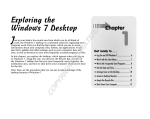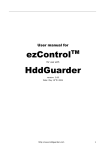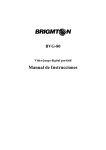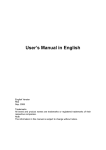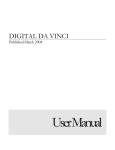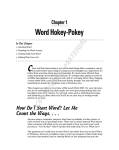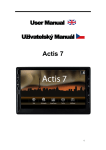Download Wiley Windows Vista Just the Steps For Dummies
Transcript
➟ TE MA TE D ust as your desk is the central area from which you do all kinds of work, the Windows Vista desktop is a command center for organizing your computer work. Here you find the Start menu, which you use to access information about your computer, files, folders, and applications. You’ll also find a taskbar that offers settings, such as your computer’s date and time, as well as shortcuts to your most frequently accessed programs or files. RI GH In this chapter, you explore the desktop, which appears when you log on to Windows Vista. Along the way, you discover the Recycle Bin, the Quick Launch bar (this might sound like a salad bar at a fast-food restaurant, but it’s actually the area of the Windows Vista taskbar that lets you open frequently used programs), and how to shut down your computer when you’re done for the day. PY Here, then, are the procedures that you can use to take advantage of the desktop features of Windows Vista. CO Chapter RI AL Exploring the Windows Vista Desktop J Get ready to . . . 1 ➟ Log On and Off Windows Vista ....................6 ➟ Work with the Start Menu ............................7 ➟ Work with the Quick Launch Bar ..................8 ➟ Set the Date and Time..................................9 ➟ Arrange Icons on the Desktop ....................10 ➟ Create a Desktop Shortcut..........................11 ➟ Empty the Recycle Bin................................12 ➟ Shut Down Your Computer ........................13 Chapter 1: Exploring the Windows Vista Desktop Log On and Off Windows Vista 1. Turn on your computer to begin the Windows Vista start-up sequence. 2. In the resulting Windows Vista Welcome screen, enter your password and click the arrow button (or click Switch User and choose another user to log on as). Windows Vista verifies your password and displays the Windows Vista desktop, as shown in Figure 1-1. (Note: If you haven’t set up the password protection feature or more than one user, you’re taken directly to the Windows Vista desktop. For more on adding and changing passwords, see Chapter 12.) 3. To log off the current user account, first save any open documents, close any open applications, and then choose Start. Then click the arrow next to the Lock button and choose Log Off. Windows Vista logs off and displays a list of users. To log on again, click a user icon. To create another user, choose Start➪Control Panel➪User Accounts and Family Safety➪Add or Remove User Accounts. Then click Create a New Account. Follow instructions to enter a name for the account and set a password for it, if you like. To log on as another user as described in Step 3, you have to enable Fast User Switching in the User Account settings. ➟ 6 Figure 1-1: The Windows Vista desktop After you set up more than one user, before you get to the password screen, you have to click the icon for the user you wish to log on as. Work with the Start Menu Work with the Start Menu 1. Press the Windows key on your keyboard or click the Start button on the desktop to display the Start menu (see Figure 1-2). 2. From the Start menu, you can do any of the following: • Click All Programs to display a list of all programs on your computer. You can click any program in the list to open it. • Click any category on the right of the Start menu to display a Windows Explorer window with related folders and files (see Figure 1-3). • Click either frequently used programs at the top left of the Start menu or recently used programs just below them. Figure 1-2: The Start menu • Click the Power button icon to close all programs and turn off Windows, or click the Lock icon to lock your computer. • Click the arrow next to the Lock button to display a menu of choices for shutting down or restarting your computer, logging off, or for logging in as a different user. 3. When you move your cursor away from the Start menu, it disappears. Open the Start menu and right-click in a blank area, and click Properties to display the Taskbar and Start Menu Properties dialog box, where you can customize the Start menu behavior. If you would rather use the look and feel of the Start menu in older versions of Windows, select Classic Start Menu in the Taskbar and Start Menu Properties dialog box and then click OK. Figure 1-3: A Windows Explorer window ➟ 7 Chapter 1: Exploring the Windows Vista Desktop Work with the Quick Launch Bar 1. Locate the Quick Launch bar on the taskbar just to the right of the Start button; if it’s not visible, right-click the taskbar and choose Toolbars➪Quick Launch from the shortcut menu (see Figure 1-4). By default, it includes the Show Desktop and Switch between Windows icons. 2. To place any application on the Quick Launch bar, as shown in Figure 1-5, right-click that application in the Start menu or on the Desktop and then choose Add to Quick Launch. You can also click and drag it to the Quick Launch bar. (If you want help creating a desktop shortcut, see the task, “Create a Desktop Shortcut,” later in this chapter.) If you have more programs in this area than can be shown on the taskbar, click the arrows to the right of the Quick Launch bar; a shortcut menu of programs appears. However, don’t create too much clutter on your Quick Launch bar, which can make it unwieldy. Logical candidates to place here are your Internet browser, your e-mail program, and programs that you use every day, such as a word processor or calendar program. Figure 1-4: The Toolbars menu When the Quick Launch bar is displayed, the Show Desktop button is available. When you click this button, all open applications are reduced to taskbar icons. It’s a quick way to clean your desktop — or hide what you’re up to! ➟ 8 Figure 1-5: Add icons to the Quick Launch bar Set the Date and Time Set the Date and Time 1. Press the Windows key on your keyboard to display the taskbar if it isn’t visible. 2. Right-click the Date/Time display on the far right of the taskbar and then choose Adjust Date/Time from the shortcut menu that appears. 3. Click the Change Date and Time (see Figure 1-6) button and in the Date and Time Settings dialog box click another date on the calendar. Enter a new time in the Time box to change the time. Click OK. 4. To change the time zone, from the Date and Time Properties dialog box click the Change Time Zone button. Choose another time zone from the Time Zone list and click OK. Figure 1-6: The Date and Time Properties dialog box 5. Click OK to apply the new settings and close the dia- log box. If you don’t want your computer to adjust for Daylight Saving Time, click Change Time Zone and click the Automatically Adjust Clock for Daylight Saving Time checkbox to turn this feature off. Another option for displaying the time or date is to add the Clock or Calendar gadgets to the Windows Sidebar. You can also drag gadgets right onto your desktop if you prefer not to leave the Sidebar displayed. See Chapter 5 for more about using the Sidebar and Gadgets. ➟ 9 Chapter 1: Exploring the Windows Vista Desktop Arrange Icons on the Desktop 1. Right-click the desktop and choose View in the resulting shortcut menu; be sure that Auto Arrange isn’t selected, as shown in Figure 1-7. (If it is selected, deselect it before proceeding to the next step.) 2. Right-click the Windows Vista desktop. In the resulting Figure 1-7: The Desktop shortcut menu, View submenu shortcut menu, choose Sort By and then click the criteria for sorting your desktop shortcuts (see Figure 1-8). 3. You can also click any icon and drag it to another loca- tion on the desktop — for example, to separate it from other desktop icons so you can find it easily. If you’ve rearranged your desktop by moving items hither, thither, and yon and you want your icons in orderly rows along the left side of your desktop, snap them into place with the Auto Arrange feature. Right-click the desktop and then choose View➪Auto Arrange. Want to quickly hide all your desktop open windows? Say the boss is headed your way, and all you have there is games? Click the Show Desktop icon on the Quick Launch bar. Poof! They’re all gone, and your job is secure. Just click items on the taskbar to display each window again. ➟ 10 Figure 1-8: The Desktop shortcut menu, Sort By submenu Create a Desktop Shortcut Create a Desktop Shortcut 1. Choose Start➪All Programs and locate the program on the list of programs that appears. 2. Right-click an item, Freecell for example, and choose Send To➪Desktop (Create Shortcut) (see Figure 1-9). 3. The shortcut appears on the desktop (see Figure 1-10). Double-click the icon to open the application. Occasionally, Windows Vista offers to delete desktop icons that you haven’t used in a long time. Let it. The desktop should be reserved for frequently used programs, files, and folders. You can always recreate shortcuts easily if you need them again. To clean up your desktop manually, right-click the desktop and choose Personalize. Click Change Desktop Icons in the Tasks list on the left. In the Desktop Icons setting dialog box that appears, click the Restore Default button, which returns to the original desktop shortcuts set up on your computer. Figure 1-9: The Send To shortcut menu You can create a shortcut for a brand new item by right-clicking the desktop, choosing New, and then choosing an item to place there, such as a text document, bitmap image, or contact. Then doubleclick the shortcut that appears and begin working on the file in the associated application. Figure 1-10: A new shortcut on the desktop ➟ 11 Chapter 1: Exploring the Windows Vista Desktop Empty the Recycle Bin 1. Right-click the Recycle Bin icon on the Windows Vista desktop and choose Empty Recycle Bin from the menu that appears (see Figure 1-11). 2. In the confirmation dialog box that appears (see Fig- ure 1-12), click Yes. A progress dialog box appears indicating the contents are being deleted. Remember that after you empty the Recycle Bin, all files in it are unavailable to you. Up until the moment you permanently delete items by performing the preceding steps, you can retrieve items in the Recycle Bin by right-clicking the desktop icon and choosing Open. Select the item you want to retrieve and then click the Restore This Item link near the top of the Recycle Bin window. Figure 1-11: The Recycle Bin shortcut menu You can modify the Recycle Bin properties by right-clicking it and choosing Properties. In the dialog box that appears, you can change the maximum size for the Recycle bin, and where it should be stored on your hard drive. You can also deselect the option of having a confirmation dialog box appear when you delete Recycle Bin contents. ➟ 12 Figure 1-12: Confirming the Empty Recycle Bin command. Shut Down Your Computer Shut Down Your Computer 1. Choose Start and then click the arrow to the right of the Lock button. 2. In the resulting shortcut menu shown in Figure 1-13, choose Shut Down to shut the computer down completely; if you want to reboot (turn off and turn back on) your computer, choose Restart. If you’re going away for a while but don’t want to have to go through the whole booting up sequence complete with Windows Vista music when you return, you don’t have to turn off your computer. Just click the Hibernate button instead (in Step 2) to put your computer into a kind of sleeping state where the screen goes black and the fan shuts down. When you get back, just click your mouse button or press Enter, or in some cases (especially on some laptops) press the Power button; your computer springs to life, and whatever programs and documents you had open are still open. Figure 1-13: The menu used to turn off or restart your computer If your computer freezes up for some reason, you can turn it off in a couple of ways. Press Ctrl+Alt+Delete twice in a row, or press the power button on your CPU and hold it until the computer shuts down. Don’t simply turn off your computer at the power source unless you have to because of a computer crash. Windows Vista might not start up properly the next time you turn it on if you don’t follow the proper shutdown procedure. ➟ 13 Chapter 1: Exploring the Windows Vista Desktop ➟ 14










